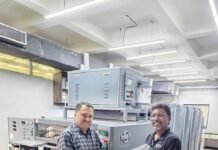HP has announced details of three new latex wide-format printers, including two new roll-fed models, the 730 and 830 series, which are updates to the existing 700 and 800 series. It has also announced a brand-new entry-level hybrid, the R530.
The 730 and 830 series are 1.63m wide roll-fed printers. For this latest incarnation, they have both gained a supposedly new Universal printhead, though this appears to be a minor reworking of the existing printhead, right down to having the same HP 836 part number. Previously, HP designated each head for a specific color, which forced customers to keep spares of all the heads in stock in case one failed. As with all HP latex printheads, these are thermal heads and so should be regarded as a consumable item.
The Universal head now leaves it to the users to keep fewer spare heads on hand, as they can choose any head for whichever color they need. That should make for simpler inventory management for both HP and its customers, and begs the obvious question as to why HP didn’t simply do that earlier?

The new printers also benefit from an embedded spectrophotometer and a new color pipeline, which HP is calling Pixel Control. This is embedded software that uses the ICC profile attached to a job and substrate to determine how best to mix the ink droplets to make a given color, regardless of what might have been selected in the RIP, to produce a more symmetrical rosette (which is the combined ink drops from the color separations). I have also been told by HP that this allows for “slightly” more accurate drop placement, which should, in turn, produce more accurate details and less banding. HP says that this should allow users to choose a mode with fewer passes and still get similar results as before.
Otherwise, the print modes and speeds for both the 730 and 830 are the same as the older 700 and 800 models, respectively. Thus, the six-pass production mode on the 700 and 730 delivers 21 square meters per hour, which drops to 17 square meters an hour for higher quality. For the 800 and 830, this same six-pass production mode produces 25 square meters per hour.
Besides the faster speed, the main difference between the 730 and 830 series is that the more expensive 830 series boasts larger ink cartridges of 3 liters over the 730-series 1-liter cartridges.
Besides the standard 730 and 830 models, there are also Latex 730W and 830W, which are the same printers but with two additional channels for white ink.

This leaves us with the baby of the group, the R530, which is perhaps the most interesting of the three. This is an entry-level printer with a print width of 1.6 m. The standout feature is that it is a hybrid, designed for both rigid and roll-fed substrates. It’s essentially a roll-fed printer that is supplied with tables on either side to convert into a printer for rigid boards.
It’s not the fastest printer. The standard mode, with 12 passes, produces 15.5 square meters an hour, while the 16-pass quality mode runs at 11.5 square meters an hour. This speed drops when printing with white, with HP quoting a 100% white spot mode at 9.2 square meters an hour.
Hidden in the footnotes, HP states that the target customers for the R530 are still printing to self-adhesive vinyl and then laminating the graphics to a board. I think it’s worth noting that, whilst doable, this technique has been obsolete for the last 20 years. Nonetheless, this is going to be a very attractive printer for anyone looking for a small entry-level device. It has a small footprint and is easy to reconfigure from rigid to flexible substrates. The print quality, judging from the samples shown at Fespa, appears to be every bit as good as one would expect from an HP latex printer, given that this is now a very mature technology.
It appears to share a similar chassis to the 830 and uses the same 3-litre ink cartridges. It prints six colors – CMYK plus light cyan and light magenta – as well as 2x white. It also includes the latex optimizer and latex overcoat, which means 10 printheads in all.
HP has also announced three customers in Germany who have been working with the R530. These include Munsteiner Werbetechnik GmbH, based in Essen and working in the healthcare sector, as well as System-repro, based in Cologne, which serves the hotel industry, trade fair construction, and interior design sectors. The third, Volker Bosl GmbH from Marwitz near Berlin, has used the printer to ditch its print and laminate workflow and print directly to rigid materials.
Besides these printers, HP has also introduced the HP PrintOS Production Hub. This is designed for remote fleet management and gives centralized access to each machine’s print queue and printer settings.
These printers should all be available worldwide now. You can find further details from hp.com.
First published in www.nessancleary.co.uk


















